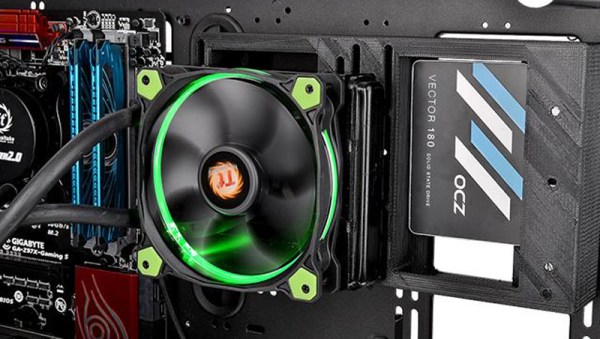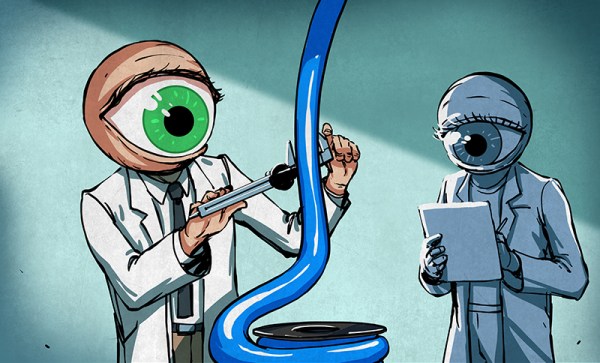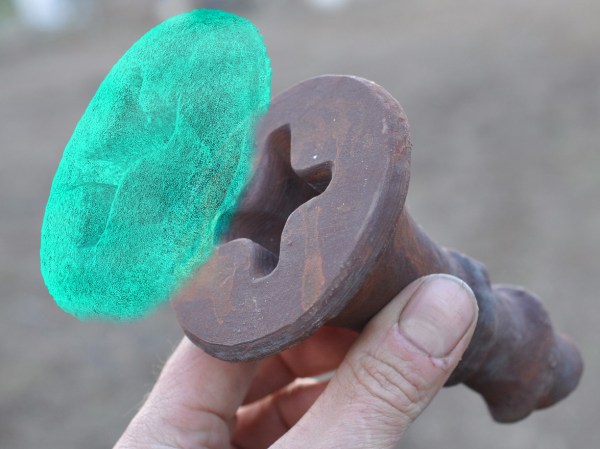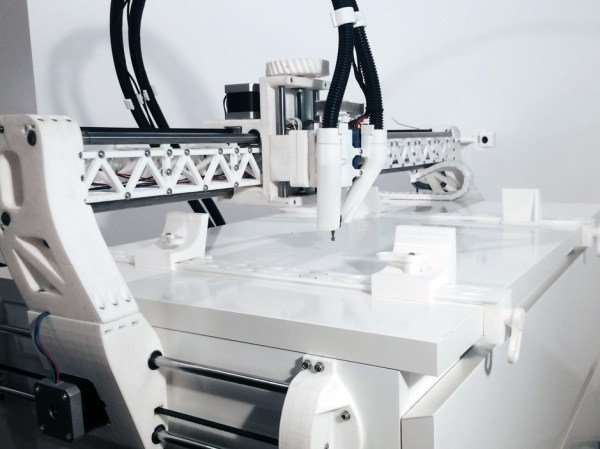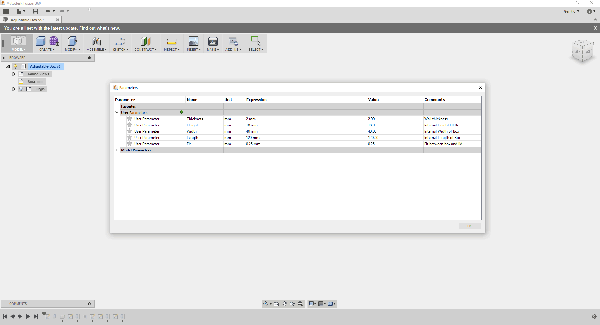If you are soldering with paste, a stencil makes life a lot easier. Sure, you can apply paste by hand with a syringe, but a modern PCB might have hundreds or even thousands of pads. Like a lot of us, [Robert Kirberich] doesn’t like paying to have stencils made and he wondered if he could use his 3D printer to make stencils. He found the answer was yes.
3d Printer hacks2753 Articles
Thermaltake Gets On The 3D Printing Bandwagon
We’re interested by a move from Thermaltake, a manufacturer of computer cases, fans, and power supplies. Thermaltake has released a computer case designed to be modded by those with a 3D printer. They released a set of models that fits the new case. These are all hosted on a service much like Thingiverse. So if you want a single SSD or a whole rack, print the model. Watercooling? There’s a model for that. In concept, it’s very cool.
We’re not certain how to feel about this. Our initial impression was that if Thermaltake is going to launch a case around 3D printing, they should at lease tune their printer and get some nice prints before they take the press photos. On our second pass we became intrigued. Is this a manufacturer cutting costs, crowd-sourcing design and engineering talent for free, or empowering the user? Arguably, a computer case is a great test bed for this kind of interaction.
Despite out skepticism, we’d like to see more manufacturers take this kind of contributing interest in 3d printing. If only to see where it goes. What other products do you think would benefit from this kind of, print the product you actually want model?
Filament Thickness Sensors, What Are They And What Are They Good For?
I keep up with the trends in 3D printing reasonably well. The other day my friend mentioned that filament thickness sensing had been added to the latest version of the Marlin firmware. I had no idea what it was, but it certainly sounded cool. I had to find out more.
In industrial settings, filament is made by pulling extruding molten plastic at a certain speed into a cooling bath. The nozzle for 2.85mm filament and 1.75 mm filament is actually the same size, but the filament is stretched more or less as it leaves the nozzle. By balancing these three variables the extrusion machine can produce any size filament desired. Like any mechanical system, it needs constant adjustment to maintain that balance. This is usually done by measuring the filament with a laser after it has cooled, and then feeding this information back into the system. The better filament manufacturers have multiple lasers and very fast feedback loops. Some of the best offer +-0.04mm or less variation in thickness between any two points on the filament. Some of the worst have larger errors such as +-.10mm. Because the plastic is fed into the extruder at a fixed linear speed, this makes a variation in the volume of the plastic coming out of the nozzle per second. With the best we see a 4.41% variation in the volume of plastic extruded. With the worst we start to see 10.51% or more.
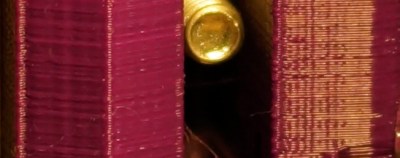
A printer is dumb. It works under the assumption that it is getting absolutely perfect filament. So when it gets 10.51% more plastic, it simply pushes it out and continues with its life. However, if the filament is off enough, this can actually show up as a visible defect on the print. Or in worse cases, cause the print to fail by over or under extrusion of plastic.
So, what does a filament thickness sensor do to correct this issue? To start to understand, we need to look at how the filament is dealt with by the software. When the slicer is compiling the G-code for a 3D print, it calculates the volume of plastic it needs in order to deposit a bead of plastic of a certain width and of a certain height per mm of movement. That was a mouthful. For example, when a printer printing 0.2mm layers moves 1mm it wants to put down a volume that’s 1.0mm long x 0.4mm wide x 0.2mm high. The filament being pushed into the nozzle has a volume per mm determined by the diameter of the filament.
The volume out per mm of filament in.
The equation we are trying to balance.
Our goal is to integrate the thickness sensor into these functions to see what the thickness sensor is doing. This is a linear equation, so there’s nothing fancy here. Now, the layer height, layer width, and length of the move are determined by settings and model geometry respectively. These are fixed numbers so we don’t care about them. That leaves us the diameter of the filament and the length of filament extruded. As we mentioned before, typically the filament is assumed to be a fixed diameter. So all the software has to calculate is the length of filament that needs to be extruded per mm of combined movement in the x and y so that our volumes match.
But, we know that one of these variables is actually changing per millimeter as well. The filament diameter! So now we have a problem. If the filament diameter is changing all the time, our equation will never balance! In order to fix this we can add a multiplier to our equation. Since we have no control over the width of the filament we can’t modify that value. However, if we know the width of the filament, and we know the value its supposed to be, we can change the length of the filament extruded. This is because unlike the filament, we have control over the stepper motor that drives the extruder. This value is called the extrusion multiplier, and its determination is what the thickness sensor is all about.
So all the filament sensor does is measure the filament’s current diameter. It takes expected diameter and divides it by the value it just measured to get a simple percentage. It feeds that number back into our system as the extruder multiplier and slows or speeds up the stepper motor as needed. Pretty simple.
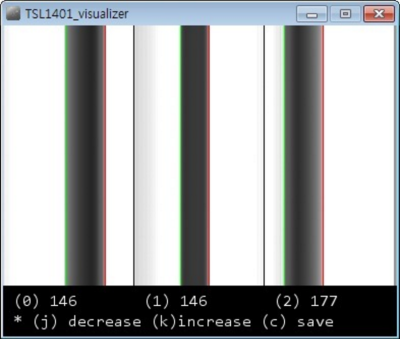
Now comes the next question,”Is it worth upgrading my printer with a thickness sensor?” If you typically run poor filament, or if you extrude your own, yes. The current sensors can only measure +- .02mm. So for the best filament, you won’t really see a difference, but for worse stuff, you might. The latest firmware of the Lyman filament extruder, for making your own filament, also supports these sensors, letting you feed back into your production system like the industrial machines. All in all a very interesting development in the world of 3D printers.
Super Detailed 3d Scans With Photogrammetry
Photogrammetry is a real word, and [shapespeare] built himself a nice setup to take high-res 3d scans using it. A good set of images for photogrammetry are: in sharp focus, well lit, precisely indexed, and have a uniform background. The background was handled by a 3d printed stand and some copier paper. To get even lighting he used four adjustable LED lamps from Ikea.
In order to precisely index the object, he built an indexing set-up with an Arduino and a stepper motor (housed in the, self proclaimed, most elegant of 3d printed enclosures). The Arduino rotates the platform a measured increment, and then using [Sebastian Setz]’s very neat IR camera control library, snaps a photo. This process repeats until multiple photos of the object have been taken.
Once the photos have been taken, they need to be run through a photogrammetry processor. [shapespeare] uses Agisoft Photoscan, but says Autodesk Memento and 123d Catch do pretty well too. After all this work it appears that [shapespeare] used his new powers to 3d print a giant decking screw. Cool.
Fully Printed CNC On An IKEA Table
It seems that many 3D printer owners just aren’t getting the same buzz they used to off their 3D printers, and are taking steps to procure heavier machines. And making them in their home laboratories with, you guessed it, their 3D printers.
Following the pattern, [Michael Reitter], designed a 3D printable CNC around a IKEA MALM table. In order to span the length of the table for his X axis, he came up with a very cool looking truss assembly. The linear rails rest on top of the truss, and a carriage with the Z axis rides on the assembly. The truss has enough space in the center of it to neatly house some of the wiring. The Y-xis mounts on the side of the table.
Overall the mechanical design looks pretty solid for what it is, with all the rails taking their moments in the right orientation. We also like the work-piece hold downs that slide along the edge of the table. It even has a vacuum attachment that comes in right at the milling bit.
We’re not certain how much plastic this build takes, but it looks to be a lot. Monetarily, it will probably weigh in at a bit more than some other options. As many in the 3D printing world are discovering, sometimes there’s no reason not to leverage more mature industrial processes for lower cost large gains in accuracy and strength. Though, it’s pretty clear that one of the design goals of this project was to see how much one can get away with just a 3D printer, and we certainly can’t deny the appealing aesthetic of this CNC.
Video of it in action after the break.
Making Parametric Models In Fusion 360
We all know and love OpenSCAD for its sweet sweet parametrical goodness. However, it’s possible to get some of that same goodness out of Fusion 360. To do this we will be making a mathematical model of our object and then we’ll change variables to get different geometry. It’s simpler than it sounds.
Even if you don’t use Fusion 360 it’s good to have an idea of how different design tools work. This is web-based 3D Modeling software produced by Autodesk. One of the nice features is that it lets me share my models with others. I’ll do that in just a minute as I walk you through modeling a simple object. Another way to describe what we’re going to learn is: How to think when modeling in Fusion 360.
New Research Sheds Light On 3D Printing Fumes
A few years back, there were some studies on the chemical and particle emissions coming out of the hotends of 3D printers. Although they galvanized a lot of people in the community, the science wasn’t entirely conclusive — one paper made it sound like you needed a hazmat suit for 3D printing, and the other suggested that cooking a meal in a kitchen was worse for you. That’s because they were measuring different things.
This new research paper on the emissions of 3D printers covers all the bases. They examined a variety of different materials printed in different printers. They also measured both chemical emissions and Ultrafine Particles (UFP) which can be hazardous even when the material itself is not.
We read the paper (PDF) so that you don’t have to. Here’s our takeaways:
 There was no significant variation across brands of 3D printers. (Duh?)
There was no significant variation across brands of 3D printers. (Duh?)- ABS and similar materials outgas styrene at levels you should probably be worrying about if you’re running your printer for a few hours a day in an unventilated office.
- PLA emitted significantly less overall, and most of it was a non-hazardous chemical, lactide. PLA doesn’t look like a problem.
- All of the materials resulted in increased UFP exposure. These levels are above normal household background levels, but lower than certain “microclimates” which (if you follow the references) include principals’ offices with carpet, automobiles, restaurants, and rooms with burning candles or running hair dryers. In short, the UFP exposure doesn’t look like it’s going to be a big deal unless you’re sitting right next to the printer and running it continually.
So what would we do? It now looks like it’s prudent to print ABS only in a well-ventilated room. Or enclose the printer in a box and vent whatever you can outside — which can also help prevent breezes cooling the piece down unevenly and adding to ABS’s warping problems. Or just stick to PLA. It looks essentially harmless.
Thanks [Jim Scheitel] for the tip!


